William Allott Firth, 1853-1923
by Brian Stevenson
last updated October, 2022
W.A. Firth is widely recognized as one of the premier diatom slide preparers of all-time. He mounted slides with single species (consisting of several specimens that illustrate different angles of view), test slides with lines of several species that have differently-sized microscopic structures, slides with arrangements of 10-12 species from a certain location, or geometric arrangements of numerous different species. From the late 1890s onward, Firth sold his preparations, either with his own labels or through professional retailers (Figures 1 and 2). In addition to diatoms, Firth also prepared slides of foraminifera, spicules from Synapta, butterfly wings and scales, and various other small objects (Figures 3 and 4).
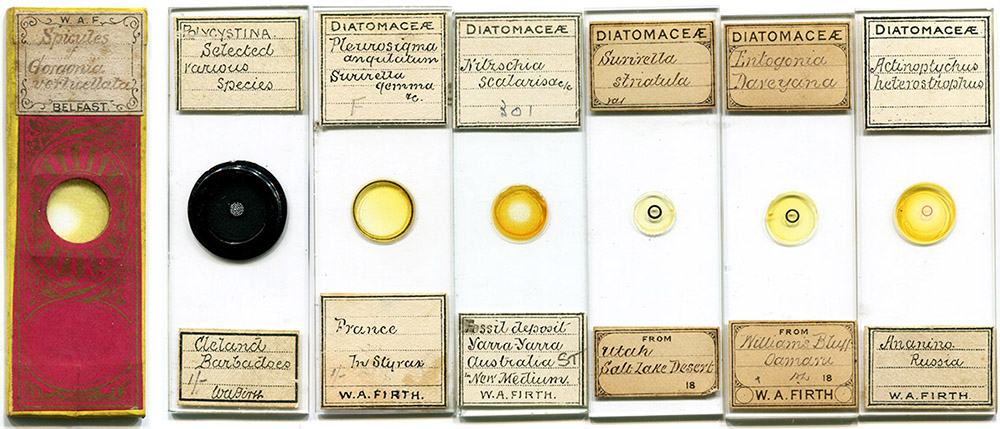
Figure 1.
Examples of microscope slides that were prepared by William A. Firth. The example on the left bears his initials and address, and is presumably a very early example of Firth’s earliest work. The next three have Firth’s name written by hand. The fourth and fifth slides from the left have identical printed labels, although the lower label on the fourth slide had Firth’s name cut off, presumably for sale by a retailer who did not want customers to know the origin of the slide.
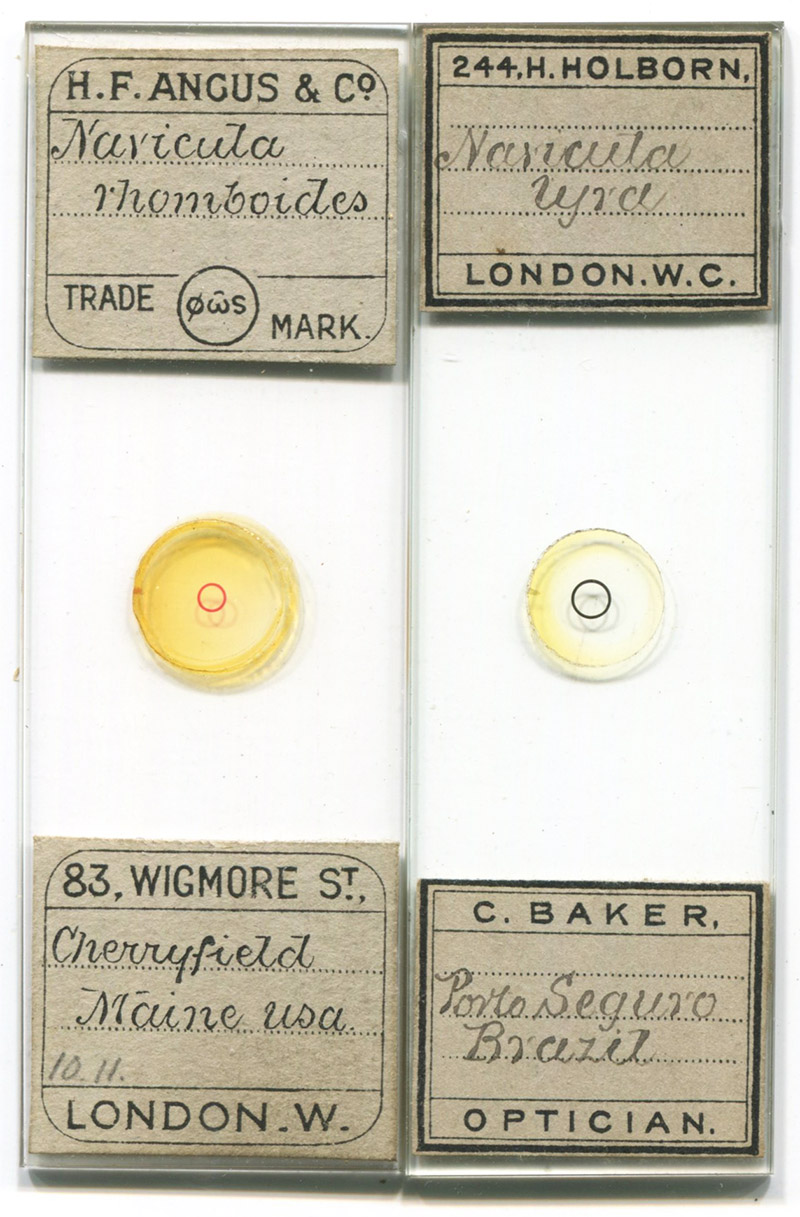
Figure 2.
Two slides that unmistakably bear Firth’s handwriting, on labels for microscope dealers Herbert F. Angus and Charles Baker. Some other retailers, such as Barbour Brothers, sold microscope slides that have handwriting similar to that of Firth, and may have been prepared by him, although I am not fully convinced of that possibility.
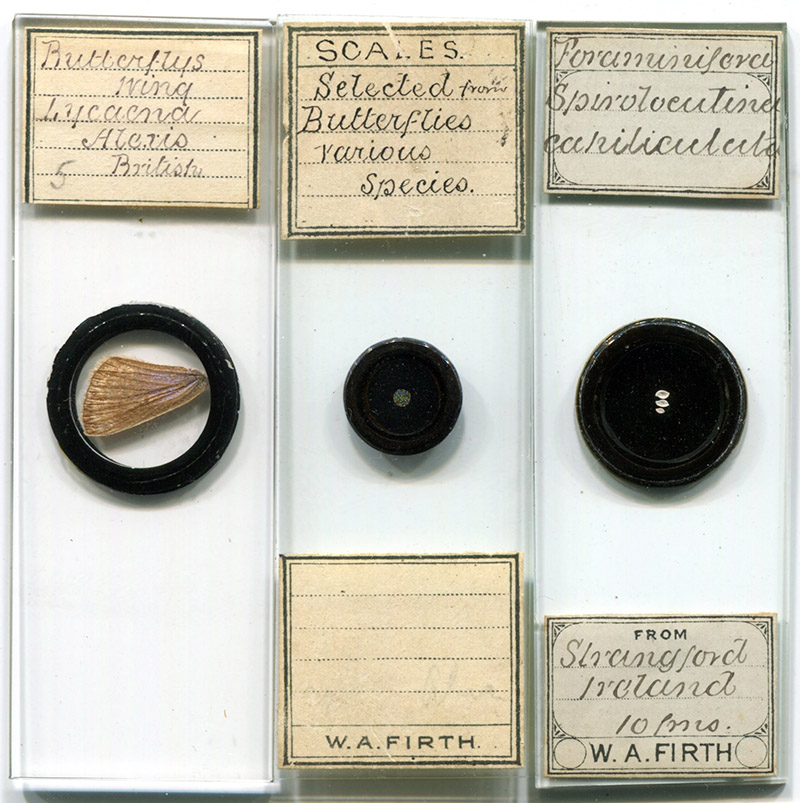
Figure 3.
Some non-diatomaceous microscope slides by W.A. Firth: a butterfly wing, an arrangement of butterfly scales, and an arrangement of foraminifera.
Figure 4.
A selection of W.A. Firth slides and photomicrographs of the specimens (not to scale):
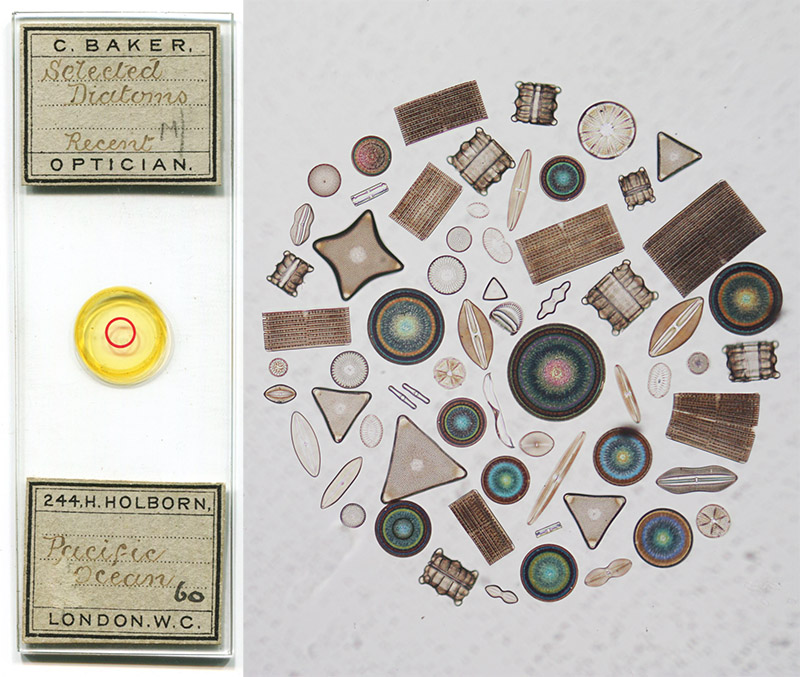
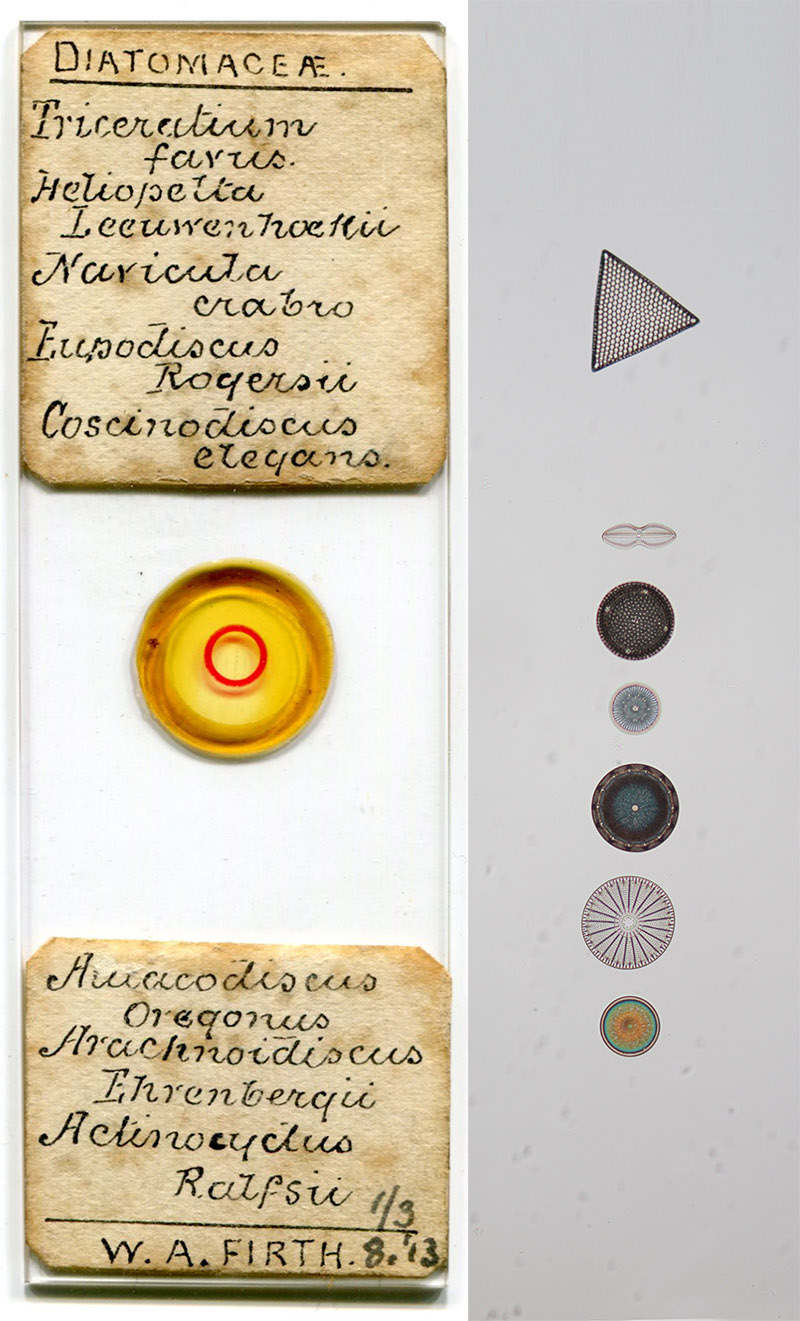
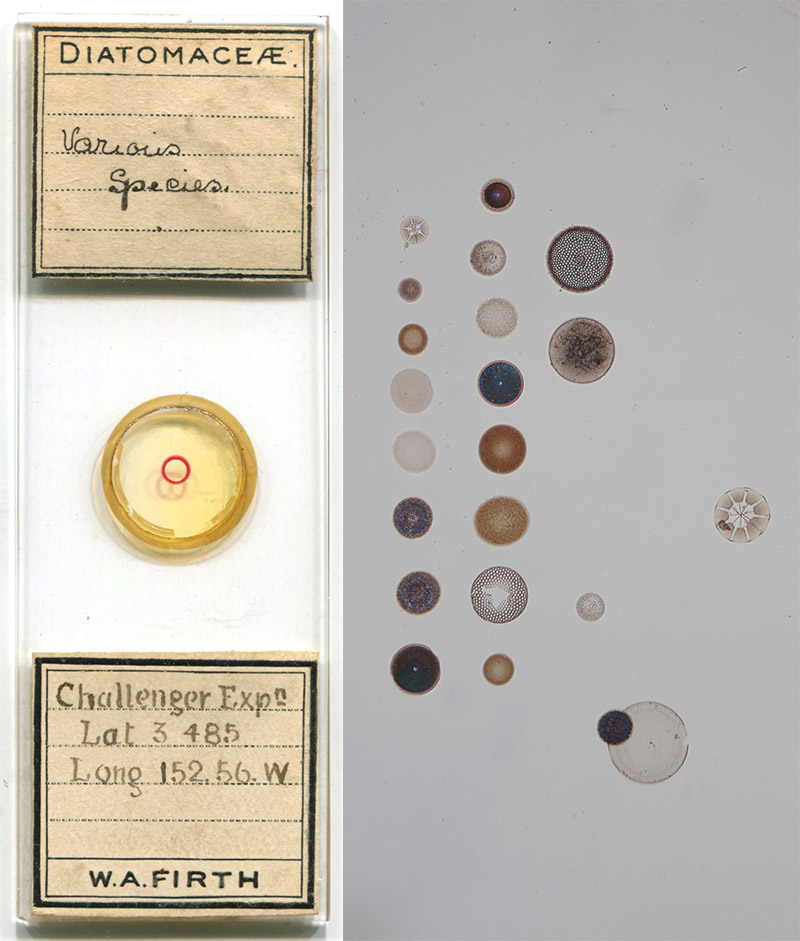
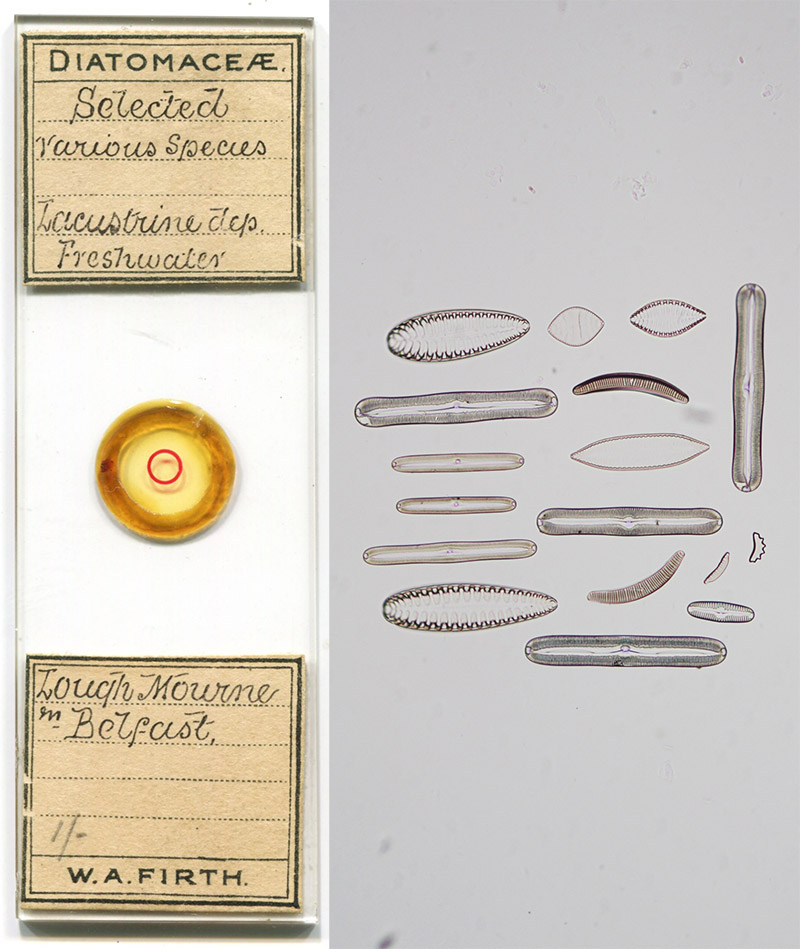
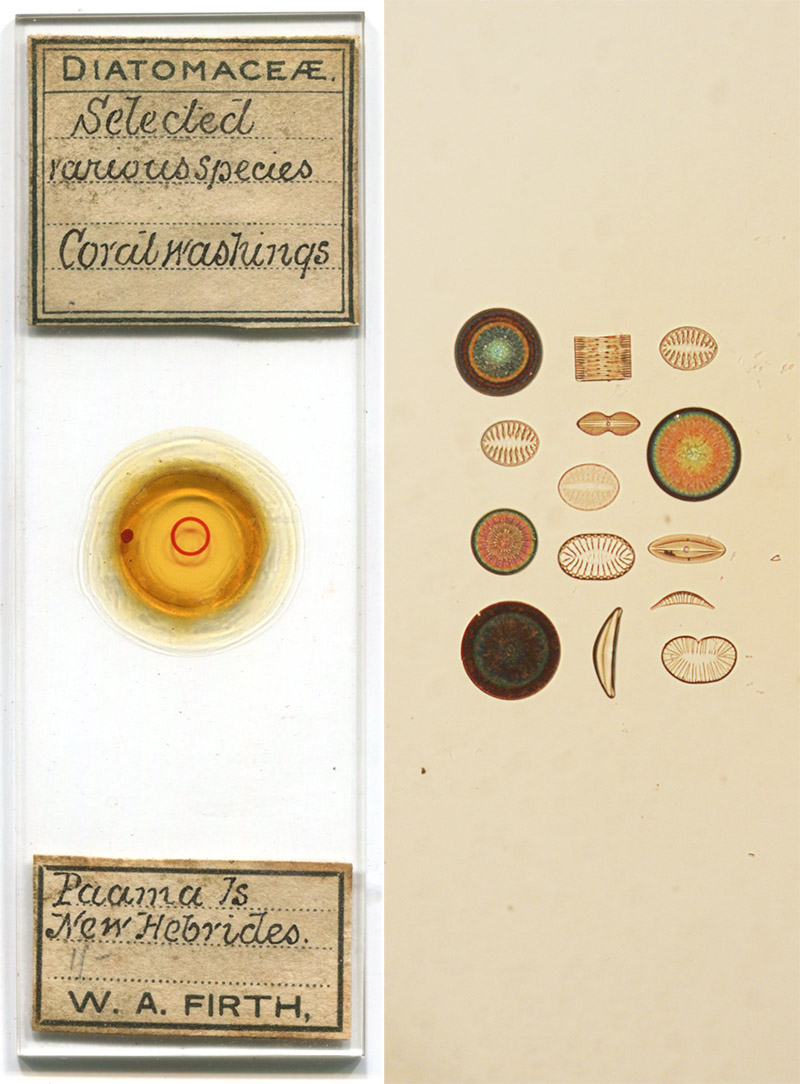
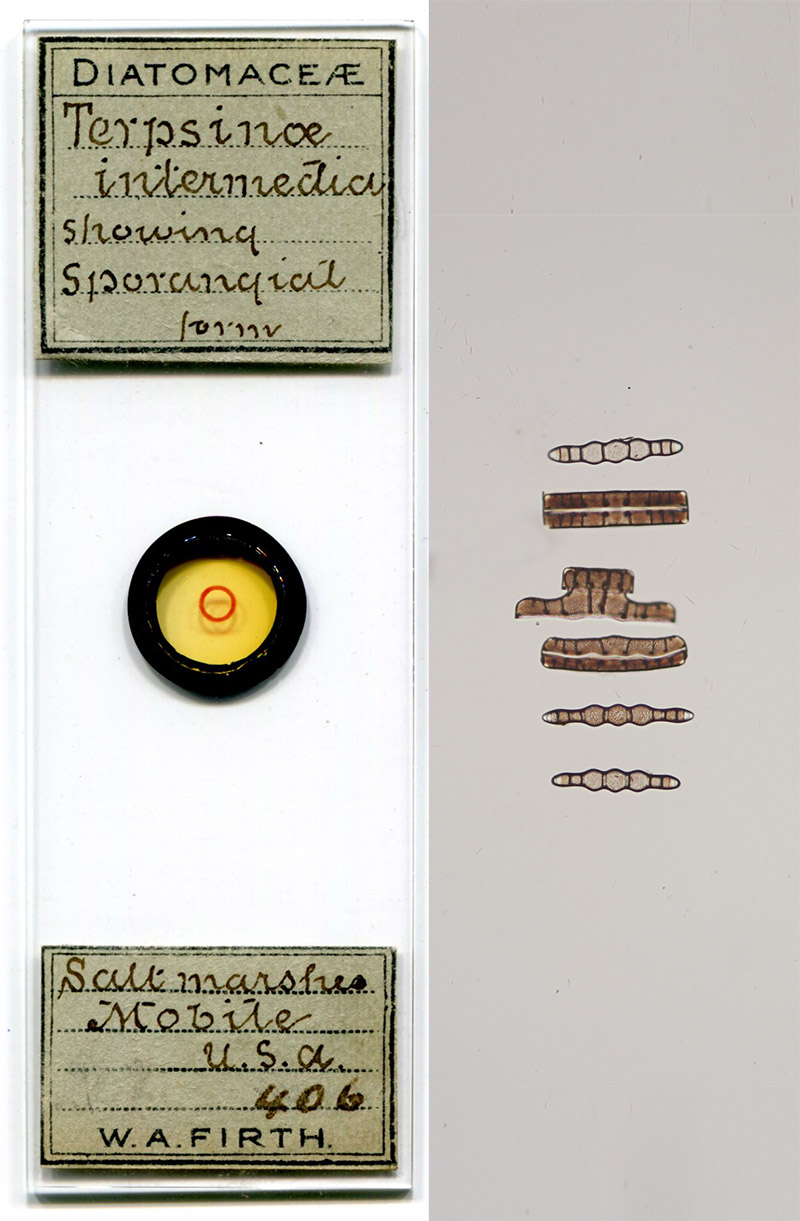
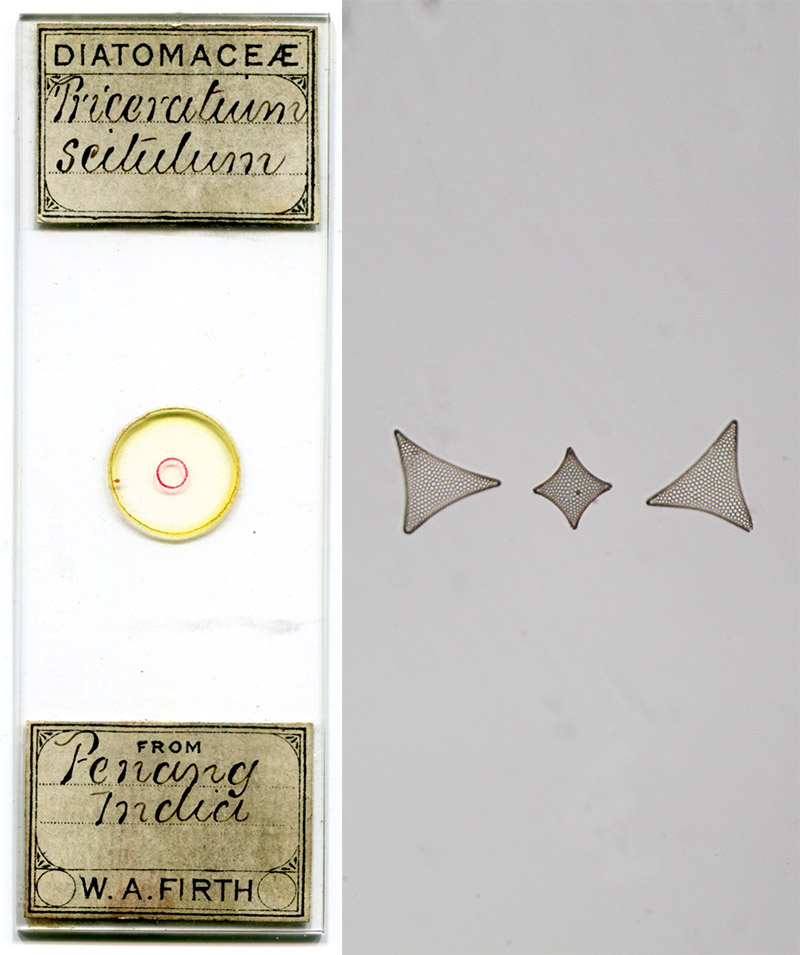
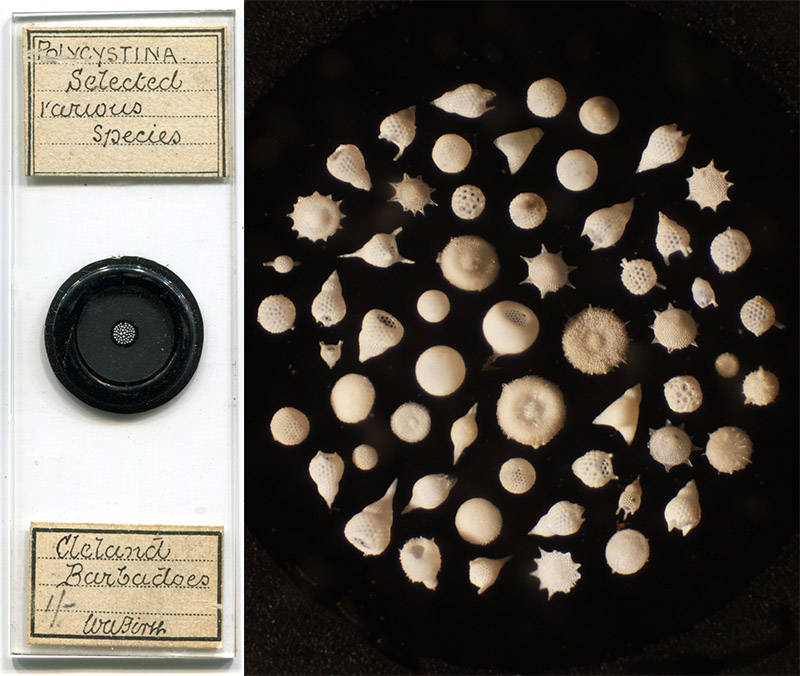
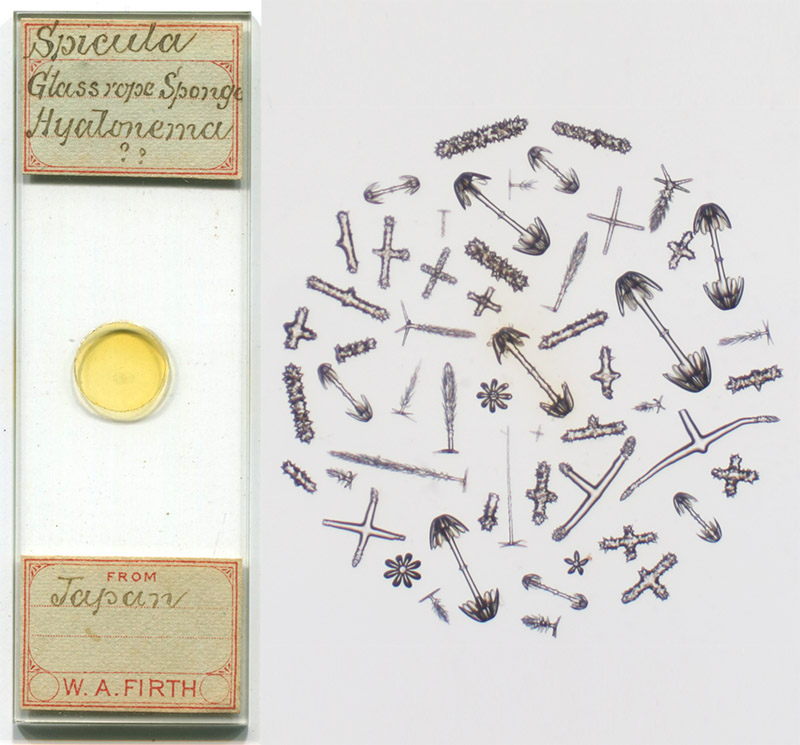
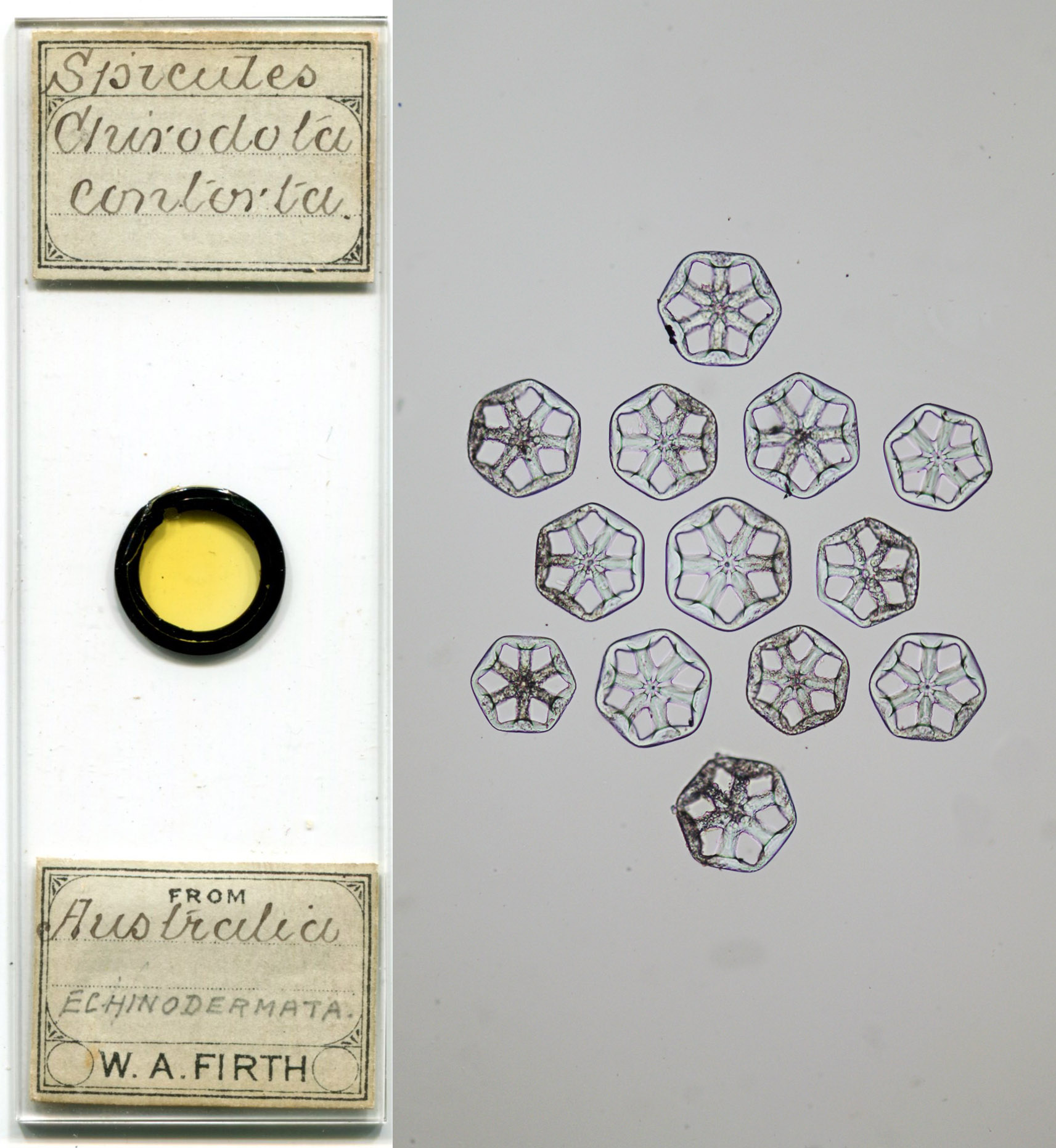
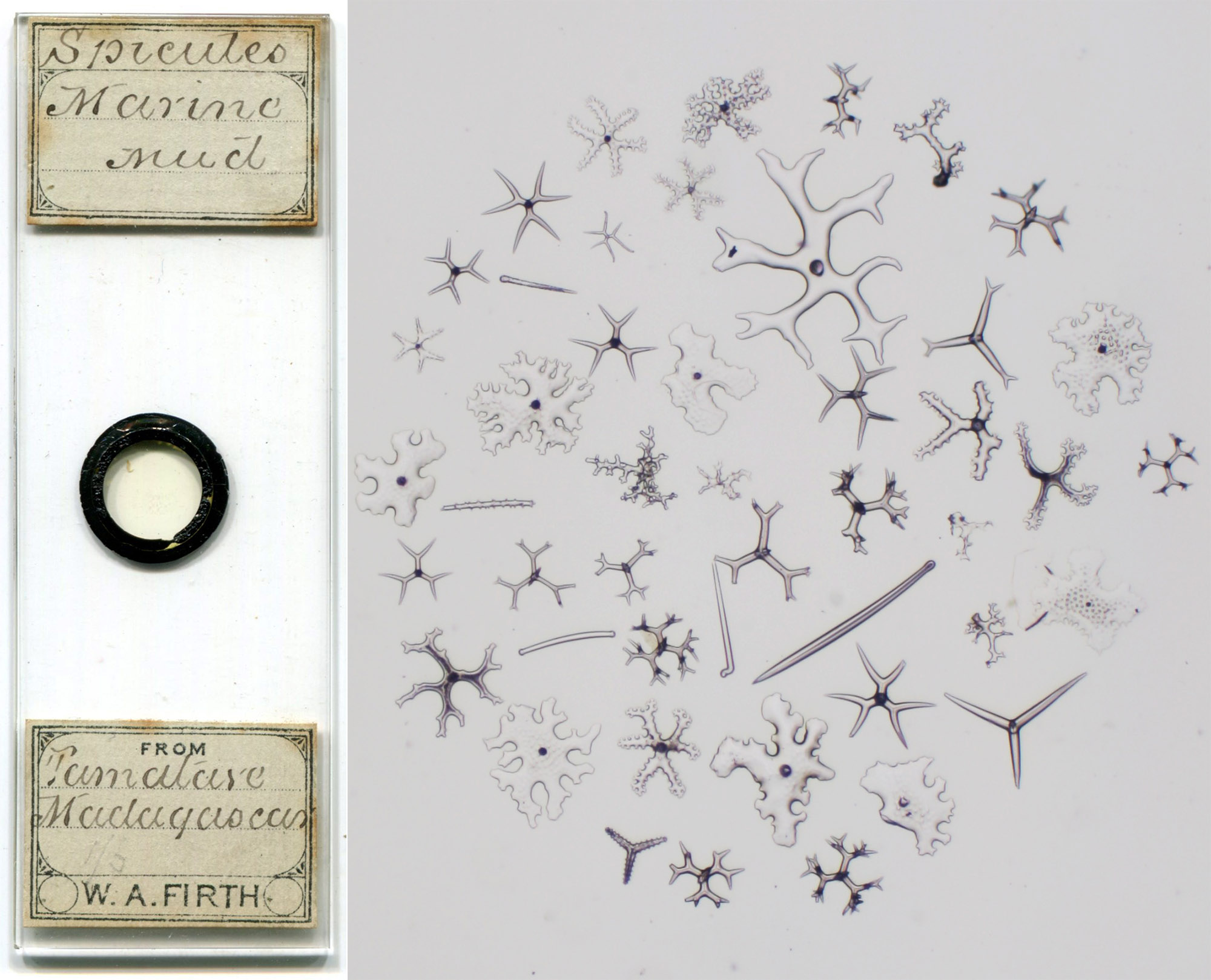
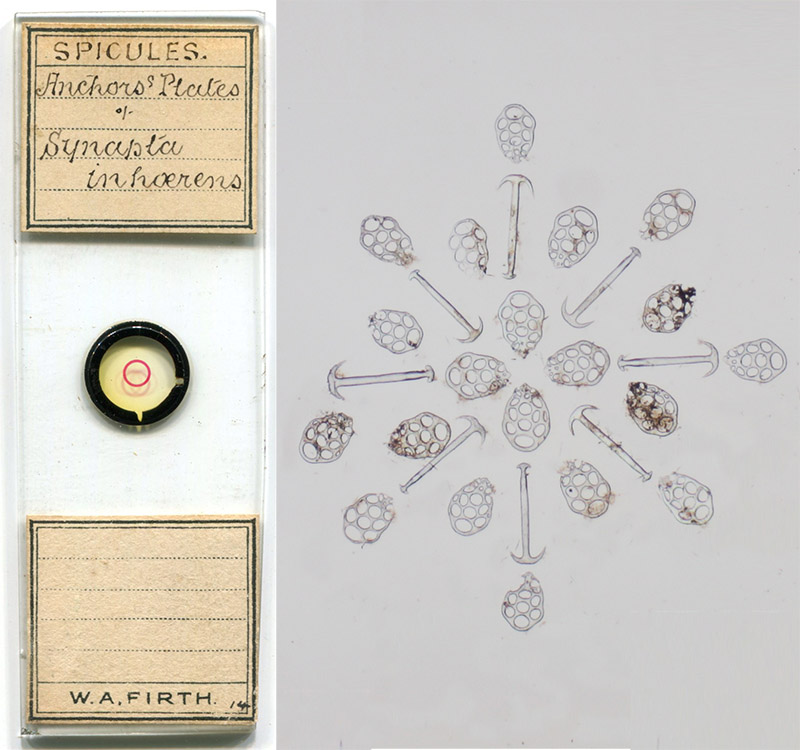
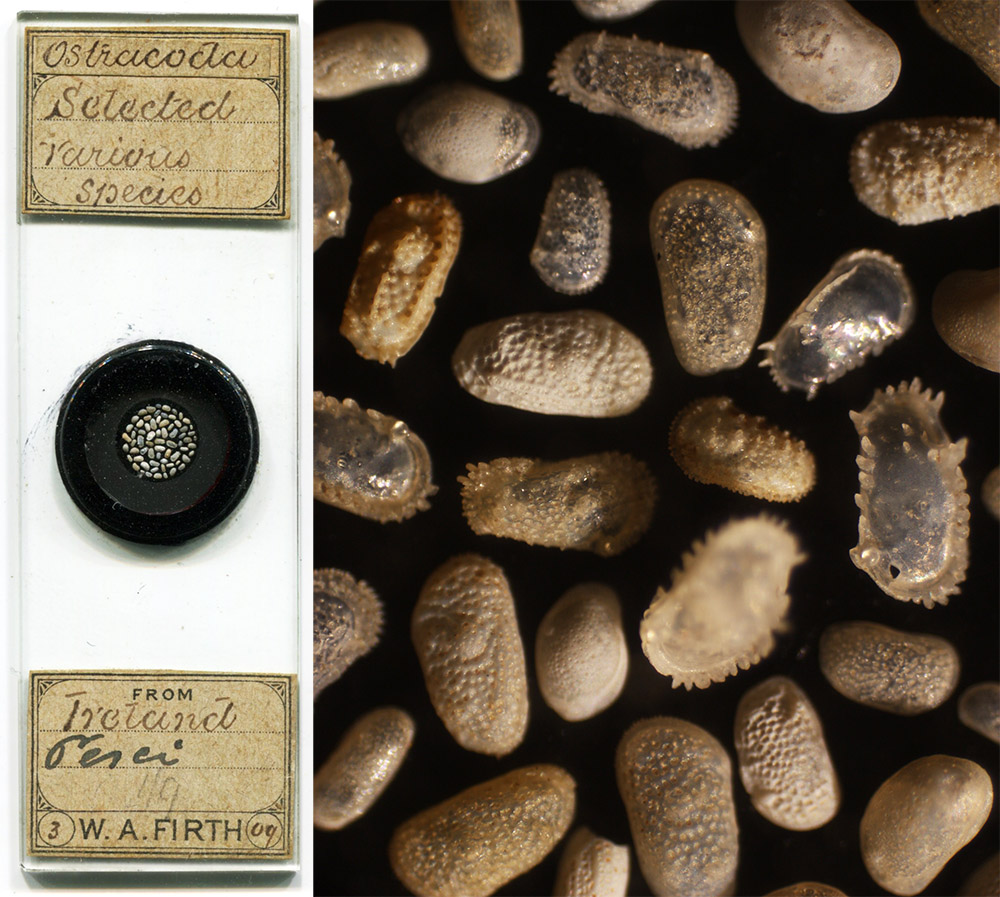
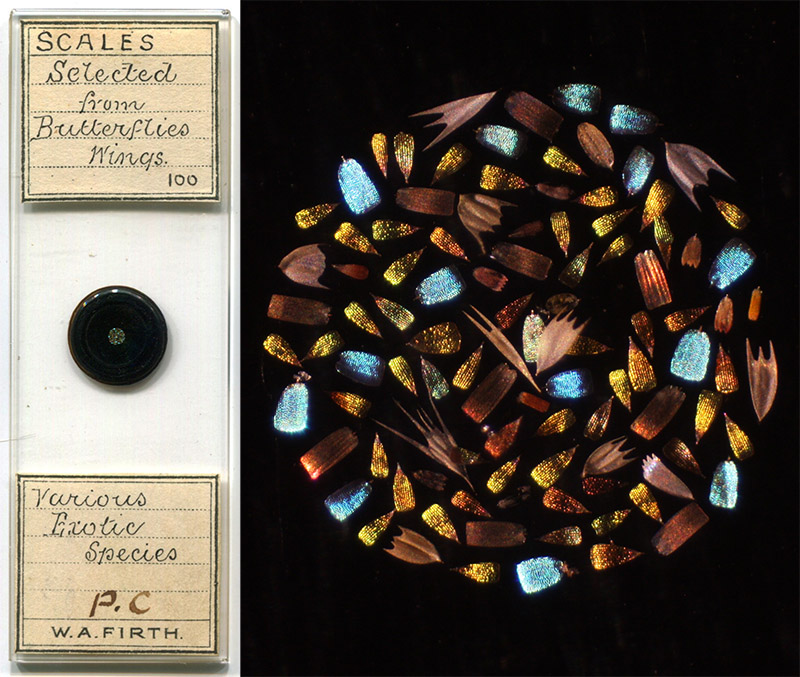
Figure 4.
A selection of W.A. Firth slides and photomicrographs of the specimens (not to scale).
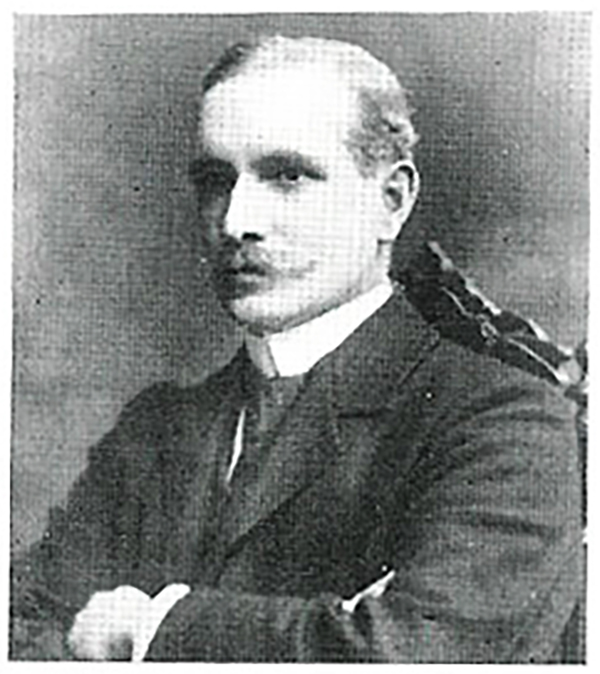
Figure 5.
An undated photograph of William Allott Firth. Source uncertain.
William Allott Firth was born in late 1853 in Swinton, Yorkshire, England. He was the first child of Joseph and Emma Allott Firth. William’s birth was followed by that of a brother and two sisters. Father Joseph was listed in the 1861 census as “manager of bleachworks”, which would have been an operation for bleaching fabric after weaving and before printing.
In the late 1860s or early 1870s, the Firths moved to the outskirts of Belfast, Ireland, where the father took on management of the Whiterock Bleachworks. The site of this operation was named New Barnsley; Joseph Firth’s previous bleachworks had been in Barnsley, Yorkshire, suggesting that Joseph’s Irish employers may have had a connection to his Yorkshire business. William also joined the bleaching business.
Both William and his father joined the local scientific society, the Belfast Naturalists’ Field Club, in 1877. William was elected to the Club’s Council in 1879. They remained members throughout their lives.
Also in 1877, William Firth published his first known exchange offers for microscopic material and slides (Figure 6). He initially offered to provide unmounted specimens and “a few slides” in exchange for prepared slides, but was offering “well-mounted slides” of his own by year’s end. Firth’s interest in diatoms was evident from an early time: in 1877 and 1878 he specifically requested samples of diatomaceous earths from New Nottingham (Virginia, USA), Monterrey Bay (California, USA), and Cuxhaven (Germany), in exchange for his preparations from County Antrim. In 1882, he was even more specific, requesting diatomaceous earth from New Hampshire, USA, that contained Amphipleura lindheimeri.
On July 22, 1881, William A. Firth was elected to membership in the Quekett Microscopical Club.
William married Ellen Stringer on April 15, 1885. By 1893, they moved to Glenview Terrace, Springfield Road, Belfast. The couple had five children, three boys and two girls.
Ownership of the Whiterock Bleachworks appears to have passes to Joseph Firth and Sons(s) during the mid-1890s.
By 1893, William Firth had obtained substantial skill in preparing microscope slides of diatoms. That year’s Proceedings of the Belfast Naturalists' Field Club gave an award, “to William A. Firth for his very superior slides of grouped diatoms, &c, a set remarkable for the amount of manipulated skill displayed in each separate slide, as well as in the taste and general excellence of the entire set”.
In 1897, William Firth placed an advertisement in the “for sale” section of an issue of The English Mechanic and World of Science (Figure 7). It is not clear how long before that date he had begun to sell significant numbers of his slides.
Edmund Spitta wrote in 1899, “We know of no mounter of diatoms in the United Kingdom that can surpass Mr. Firth, of Clifton Park Avenue, Belfast, and few that can equal him, save Mr. Gatrell, of Barnes, whose work is of the most excellent quality; but Thum, of Leipzig, and Moller, of Wedel Holstein, also supply slides of exceptional merit and perfection”. Illustrated essays on the lives and works of those other diatom-mounters are also posted on this site.
The 1901 Belfast Street Directory listed William Firth’s home address as 215 Springfield Road. Joseph Firth & Sons, Ltd., “bleachers and finishers”, were also located on Springfield Road. The 1901 census recorded William’s occupation as “linen bleacher”. William and family evidently lived at, or very near, his fabric works.
Advertisements from William Firth were published until nearly the time of his death (Figures 8 and 9). It is likely that the majority of Firth’s microscope slides were produced during his professional period, from the mid-1890s until early 1920s. Of note, during 1912 he published a series of advertisements for slides of “12 selected diatoms” from various global localities.
A friend, Herbert Potter, of Birmingham, England, later shared a letter from Firth with the magazine "The Microscope", which described Firth's microscope setup, "After years of practice and experience I have cut down on my methods to the simplest possible system. My microscope was originally a Crouch's Student's Binocular with a square stage. As the left hand tube was in the way, and of no use in mounting, I took it away some years ago, and over the eyepiece I have a Leitz Erecting Prism which is very useful and allows the microscope to be set upright or slightly tilted as required".
William Allott Firth died on July 26, 1923, and was buried in the Belfast City Cemetery.
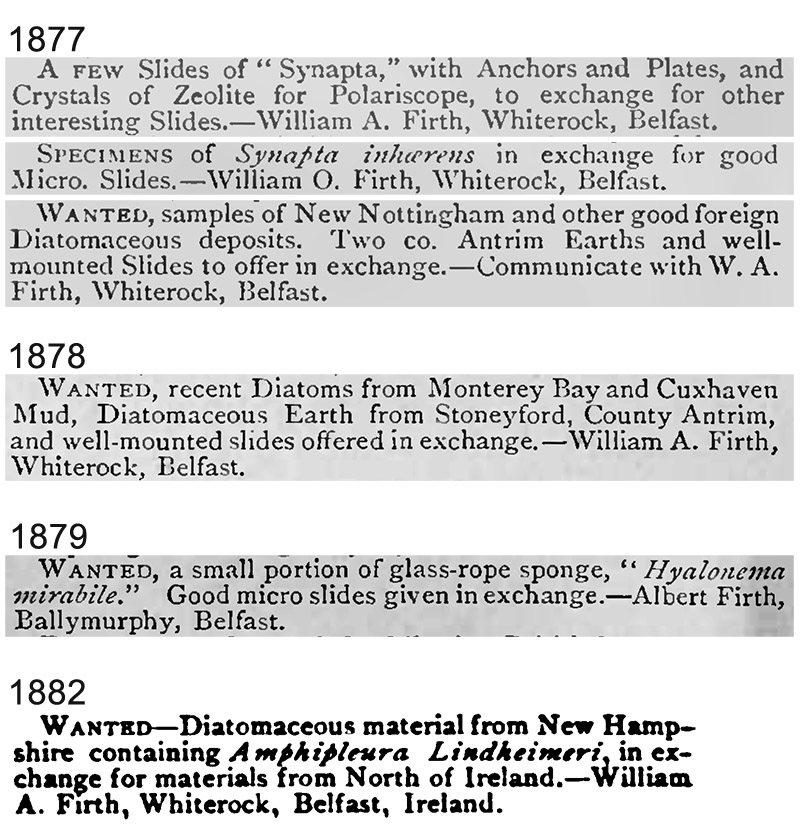
Figure 6.
The earliest known exchange advertisements of William A. Firth, from “Hardwicke’s Science-Gossip” (1877, 1878, and 1879), and “American Monthly Microscopical Journal”. Such far-ranging advertisements brought him specimens from around the world. Note that the 1879 exchange offer misspelled Firth’s given name - he probably signed the submission as Allott Firth.

Figure 7.
An 1897 advertisement for the sale of microscope slides. From “English Mechanic and World of Science”.
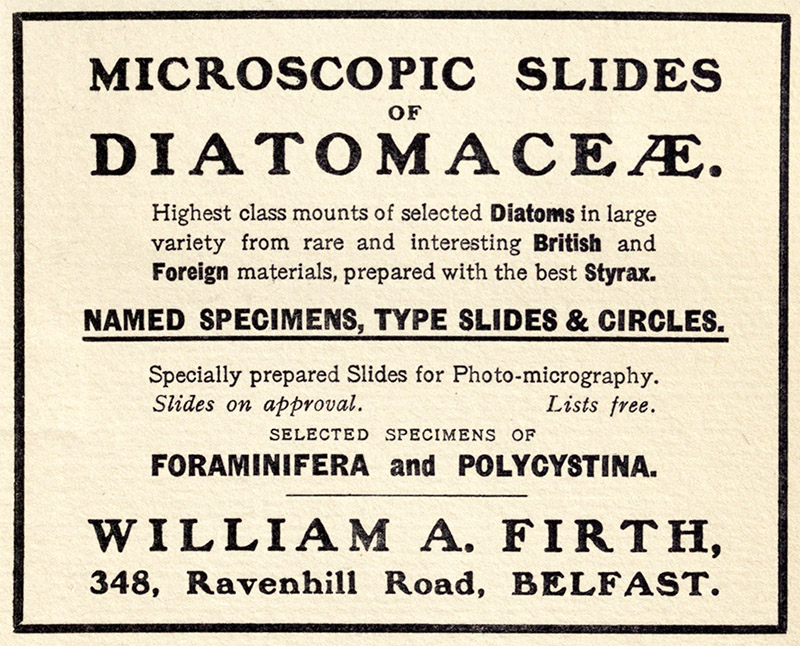
Figure 8.
A 1909 advertisement, from Walter Bagshaw’s “Elementary Photo-Micrography”.

Figure 9.
A 1922 advertisement, from “The Journal of the Royal Microscopical Society”.
Resources
The American Monthly Microscopical Journal (1882) Exchange offer from William A. Firth, Vol. 3, page 220
Annual Report and Proceedings of the Belfast Naturalists' Field Club (1876-77) neither Firth listed as a member
Annual Report and Proceedings of the Belfast Naturalists' Field Club (1877-78) “Members: … W.A. Firth, Whiterock … J. Firth, Whiterock”, page 278
Annual Report and Proceedings of the Belfast Naturalists' Field Club (1893) “We have pleasure in awarding to William A. Firth for his very superior slides of grouped diatoms, &c, a set remarkable for the amount of manipulated skill displayed in each separate slide, as well as in the taste and general excellence of the entire set”, page 6
Annual Report and Proceedings of the Belfast Naturalists' Field Club (1896) “Members: … Firth, Joseph, Whiterock … Firth, W.A., Glenview Terrace, Springfield Road”, page 278
Bagshaw, Walter (1909) Elementary Photo-Micrography, 2nd edition, Iliffe & Sons, London, advertisement from W. A. Firth in rear of book
Belfast Street Directory (1877) “Firth, Joseph, Whiterock Green, manager”
Belfast Street Directory (1880) “Firth, Joseph, Whiterock Green, New Barnsley, manager … Whiterock Bleaching Co. - Joseph Firth & Son, proprietors”
Belfast Street Directory (1890) “Firth, Joseph, farmer & bleacher, Whiterock House … Whiterock Bleachworks, New Barnsley, Foster Connor & Co., proprietors”
Belfast Street Directory (1901) “Firth, Joseph, & Sons, Ltd., bleachers and finishers, Springfield Road; res., Joseph Firth, Goshen, Ballymagarry … Firth, W. A., 215 Springfield Road”
Belfast Forum (accessed November, 2019) “the first references to New Barnsley I can see, both in old newspapers and Belfast street directories, appear from the early 1870s onwards and those early references are nearly all in connection with the Firth family and the Whiterock Bleaching Company and Bleach Green. Joseph Firth was the manager of a bleach works and moved to Belfast in the 1860s from... Kexbrough, Yorkshire (today a village in the Metropolitan Borough of Barnsley)”, http://www.belfastforum.co.uk/index.php?topic=76598.0
England census and other records, accessed through ancestry.com
English Mechanic and World of Science (1897) Advertisement from William A. Firth, Vol. 66, page 76
Find-a-Grave (accessed November, 2019) description of William Allott Firth’s gravesite, https://www.findagrave.com/memorial/183254810
Gill, Steve (2013) W.A. Firth species list, and Some notes on William Allott Firth, The Amateur Diatomist, Vol. 5
Hardwicke’s Science-Gossip (1877) Exchange offers from William A. Firth, Vol. 13, pages 144, 192, and 264
Hardwicke’s Science-Gossip (1878) Exchange offer from William A. Firth, Vol. 14, page 72
Hardwicke’s Science-Gossip (1879) Exchange offers from William A. Firth, Vol. 15, pages 96 and 168
Ireland census records, accessed through http://www.census.nationalarchives.ie
The Journal of the Quekett Microscopical Club (1881) “July 22nd, 1881, annual meeting … The minutes of the preceding meeting were read and confirmed. Mr. William A. Firth and Mr. Henry Perigal were balloted for and duly elected members of the Club”, page 326
Journal of the Royal Microscopical Society (1922) Advertisement from W.A. Firth, page 485
The Microscope (1956) Letter, Vol. 10, page 108
The Naturalists' Universal Directory (1905) “Firth, Mr., Clifton Park Ave., Belfast, Diatoms, esp. expert mounter”, Cassino, Boston, page 288
Paisley, Peter (2012) The familiar - and not so familiar - W.A. Firth: his life and times in Belfast, http://www.microscopy-uk.org.uk/mag/artdec12/pp-Firth.docx
Spitta, Edmund Johnson (1899) Photo-micrography, The Scientific Press, London, pages 129-130





















